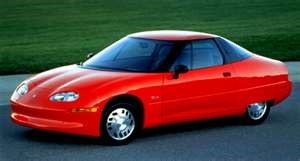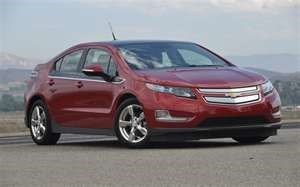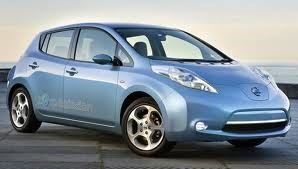I. Introduction
Topic 11 Overview
Concepts
- Voltaic cells and potentials
- Understanding how to use a table of standard reduction potentials
- Nonstandard conditions and the Nernst equation
- Fuel cells
Skills
- Constructing electrochemical cells
- Reading directions and troubleshooting the renewable energy kit
- Data analysis
From December 1996 through August 2004, General Motors (Saturn division) leased the first commercially-available electric cars (EV1) in California and Arizona (Fig. 12.1). The EV1 was capable of 0 to 60 mph in less than nine seconds and had a range of approximately 75 -130 miles. General Motors developed this vehicle in response to a government mandate. To combat southern California’s air pollution problem, the State of California and the Environmental Protection Agency (EPA) established laws to mandate the use of zero emission vehicles (ZEVs). Starting in 1998, California law required that 2% of all the vehicles sold in California by the seven major auto companies had to be ZEVs and 10% by the year 2003. (Annual auto sales in California are about 1.3 million cars per year.)

The EV1 was the first battery-powered car to be put into general production, but others have followed. The current state of battery technology is the main limiting factor in electric vehicle design. Within the chassis of the original EV1 were twenty-six 12-volt lead-acid batteries (1175 pounds!) capable of storing 16.2 kilowatt hours of energy. Today nickel-metal-hydride batteries are replacing lead-acid batteries. Although a single battery charge is only equivalent to the energy released from burning about half of a gallon of gasoline, electric engines can be made 85% efficient (gasoline engines are only about 25% efficient) thus making it possible for the car to travel almost 250 miles per charge. Today’s lithium ion batteries can be totally charged (0 to complete) in 4 hours; partial charges can be done in less time.
Production of the EV1 stopped in 2004 due in part to a lack of consumer appeal. General Motors spent over $1 billion dollars on research and development of the car, but yet were only able to lease 800 vehicles in a four year period. At the time, consumers were not willing to lease the car because it did not meet the needs of their current lifestyle; the EV1 could only hold two passengers and had a limited range. Despite GM’s struggles with their first generation electric car, they have continued to develop their next generation of electric cars, the Chevrolet Volt (Fig. 12.2), which was introduced in December 2010 and can use both electric and gasoline power. Other manufacturers have their own electric vehicle option in development or now available for purchase. Nissan introduced the Leaf in December 2010 which is the first electric battery-powered vehicle made widely available to the public by a major manufacturer.

 Figure 12.2. Chevy Volt (top), Nissan Leaf (bottom).
Figure 12.2. Chevy Volt (top), Nissan Leaf (bottom).In the meantime, the technology gained through the EV1 and similar electric cars has been applied to the development of hybrid vehicles, which use both internal combustions engines and electric motors, and of fuel cell vehicles. Hybrid vehicles, such as the Toyota Prius, Honda Civic and Ford Escape, have been increasing in popularity for their increased gas mileage and reduced emissions. Although not true batteries, fuel cells are being developed as a replacement for a battery because they are much more efficient than any batteries currently in use. The simplest fuel cell involves the reaction of hydrogen gas with oxygen in a basic solution, generally potassium hydroxide. These cells operate at about 70% efficiency as opposed to the efficiency of most batteries, which range from 35%-40%. This type of fuel cell is used in spacecraft. Despite difficulties in shipping, storing and transferring extremely large quantities of hydrogen gas for use in vehicles, General Motors was contracted by the U.S. federal government to produce the first test fleet of hydrogen fuel cell vehicles, which were deployed in New York, Washington D.C., and California in early 2008. Then in July 2008, the Honda FCX Clarity became the first commercially available fuel cell vehicle for lease in the U.S. Finally, other hydrocarbons, such as propane, butane, or diesel fuel, are currently being investigated as fuels. Any of these substances on reaction with oxygen would generate water and carbon dioxide.

